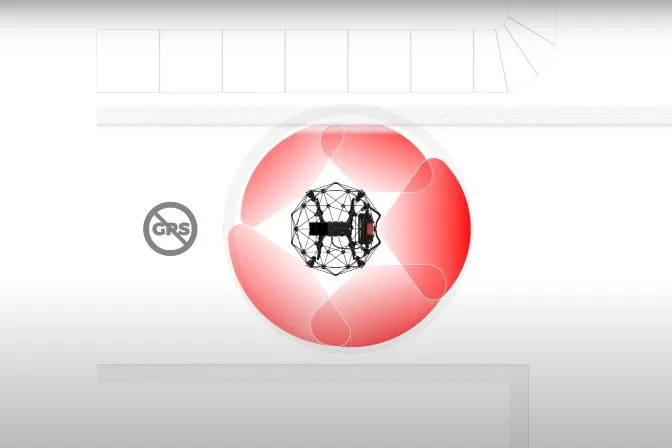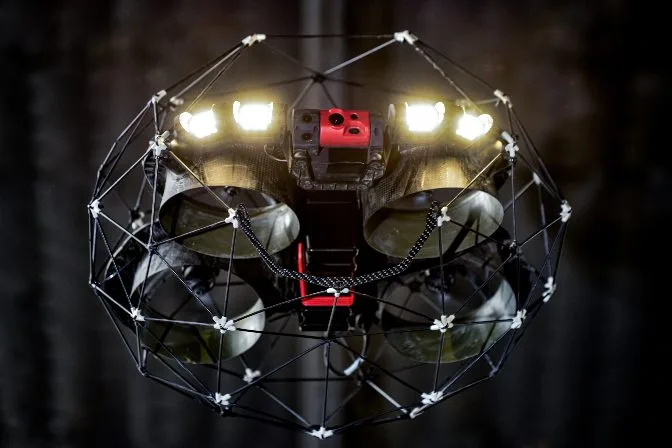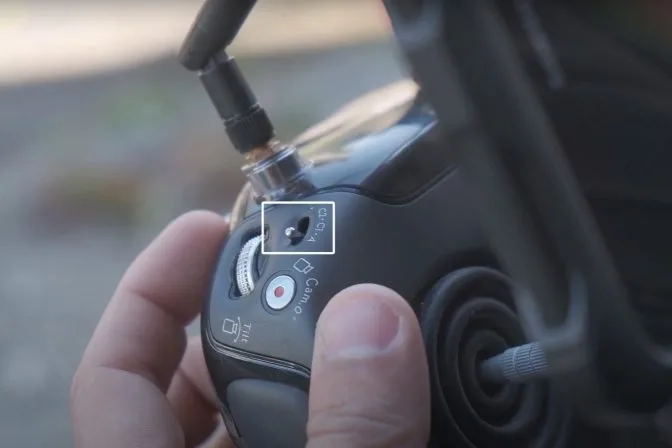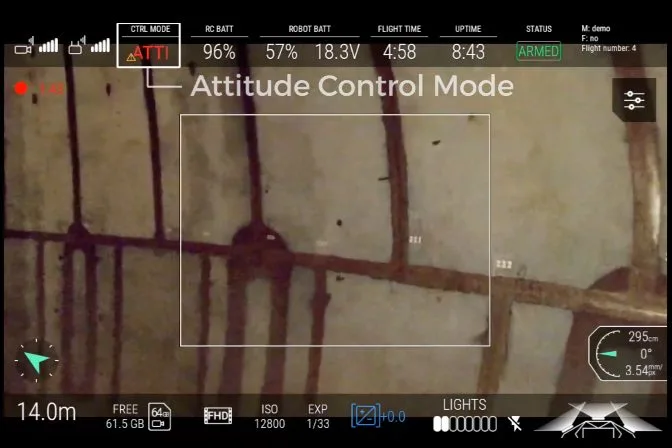- Blog >
- ATTI Mode: A Guide
ATTI Mode: A Guide
ATTI mode, or Attitude Mode, is the most manual way to fly a drone.
As drone technology develops, there has been a shift towards automated features that reduce pilot workload. Advanced sensing technology and intelligent flight modes have made flying a drone easier than ever before.
However, there are some valuable applications for when ATTI mode is a must, namely for performing indoor inspections where the Global Positioning System (GPS) is not reliable.
In this flight mode, the pilot intervenes to directly control the drone's attitude, and the optical sensors are disabled. A pilot should enable drone ATTI mode if they notice unpredictable behavior and stability issues due to the limitations of optical sensors in challenging scenarios.

No GPS zone
What Is ATTI Mode?
ATTI mode is when you are flying without intelligent flight features like GPS positioning and optical sensors. You are flying the drone manually without any assistance or automatic corrections when flying ATTI mode.
Most pilots typically fly their drone in either GPS or OPTI mode. However, in ATTI, the lack of satellites and sensors for positioning means the drone can sway in different directions and lose altitude without pilot inputs. For this reason, all drone pilots should understand how to fly in ATTI mode if they can't rely on the drone to do the heavy lifting.
[Related read: What Is a GPS-Denied Drone?]
When to Use ATTI Mode
Drones with ATTI mode are not as common as they once were. Earlier drones had the unique feature of being able to turn on attitude mode, but in the case of indoor drone technology, this capability is essential.
A drone cannot connect to satellites when flying indoors, which is where ATTI mode shines. With indoor drones being used for inspections in mines, sewers, and other indoor or confined spaces, GPS is not always reliable enough to fly in ATTI mode.
Due to the extreme dangers and unpredictability of mining, the mining industry has been an early adopter of using indoor drone technology.
Specialized drones like the Elios 3 are specifically designed to fly in GPS-denied environments using ATTI mode. As you can imagine, there is no chance of having a GPS connection thousands of feet below the surface of the earth.
[Related read: Why We Made The Elios 3]
 The Elios 3
The Elios 3
Common Use Cases for ATTI Mode
ATTI mode is a useful flight setting when the GPS signal is affected or out of range.
-
Indoor inspections. Drones are used to inspect boilers, sewers, tanks, mines, and other enclosed spaces out of GPS range.
-
Bridge inspections. Large metal support beams significantly reduce GPS signal accuracy.
-
Building inspections. Buildings are constructed using vast amounts of concrete and steel. The rebar and steel used for these structures can cause signal interference.
-
Critical infrastructure. Sensitive government facilities like military bases restrict the use of GPS signals for security reasons.
The Elios 3 has flight modes optimized for demanding flight environments requiring precision and accuracy.
How Does ATTI Work?
Using ATTI mode puts the pilot in complete control of the aircraft. Creature comforts like visioning positioning systems and GPS systems are unavailable in this mode, so it’s truly a manual flight mode.
Drones with ATTI rely on an onboard barometer, which measures air pressure to determine the pressure altitude. Doing so helps keep the aircraft level. However, it will not prevent the drone from drifting in different directions if acted upon by wind.
What Conditions Can Trigger ATTI Mode Automatically?
-
Flying over highly reflective or monochromatic surfaces
-
Operating a drone with dirty vision positioning system sensors
-
Flying near concrete and large metal structures
-
Using high-speed flight modes, making it difficult to obtain a signal
Benefits of Flying in ATTI Mode
In most cases, ATTI mode is a fail-safe setting that triggers when GPS is unavailable. However, there are various reasons why you should use it.
1. Helps You Prepare—and Be Ready—for the Unexpected
When flying a drone, many factors can make it an unpredictable event. Signal loss, interference, and other malfunctions can quickly turn a good flight into a disaster.
Knowing how to fly a drone in ATTI mode will reduce your reliance on GPS and position systems, preparing you for the worse.
2. It’s Optimized for Flying Indoors
Indoor drone operations certainly present risks and challenges because of obstacles and signal interference. Attempting to use a GPS drone indoors can be dangerous as it can become erratic and confused. Unlike regular flight modes, ATTI only relies on barometer sensing technologies and a skilled pilot.
3. You’ll Get Smooth Footage
While flying a drone in its normal state is more manageable, it doesn't necessarily mean it records the best footage. A common pitfall is a drone will make positioning corrections throughout the flight. The adjustments can cause your footage to appear jittery, affecting the overall quality.
The lack of stabilization mechanics will result in a smoother flight. For this reason, many professional photographers and filmmakers will fly their drones in ATTI mode. Of course, this takes lots of practice, and it's not something you will catch onto the first time.
ATTI Mode Flying Tips
Being capable of flying in ATTI mode smoothly takes time and practice—and it's not something you will get the hang of on the first go.
1. Start Off Slow
Remember the first time you flew a drone? You were probably quite uncertain how it would go. If you have relied on the GPS flight mode for years, it can be easy to think, "oh, I can handle ATTI easily." In reality, it's a different beast to tackle.
Pretend you have never flown a drone and perform basic flight maneuvers. Rushing this process will only result in one thing, crashing!
Here are some flight modes to try:
-
Taking off and hover
-
Landing the drone
-
Hover in place
-
Flying in a figure-eight pattern
-
Try performing roll, pitch, and yaw movements

2. Fly Your Drone in a Wide-Open Space
Flying in ATTI mode is nothing like the regular flight modes. Always practice in a large field or open space without people nearby. It's also best to avoid areas with ponds, lakes, rivers, etc.
Do your best to keep the drone within a manageable range. The further away the drone is, it will be harder to determine the attitude without using the onboard camera. Once you can assess the position of your drone with your eyes, try using the video feed.
The live footage can be helpful by using obstacles to help you evaluate its position relative to your surroundings. Crashing the drone is not always a guarantee, but the increased probability during the learning phase is high.
3. Monitor Weather Conditions
Drifting is usually corrected in GPS mode, but flying in ATTI removes this safeguard. As a precaution, be mindful of weather conditions, especially the wind. Strong winds will severely impact performance and your ability to maintain control of the drone.
As you become more comfortable, try flying in stronger winds. Having this experience will make you a better pilot when the unexpected happens.
4. Practice on an Inexpensive Drone
The last thing anyone wants to do is to crash their expensive drone. Many cheap drones for sale do not have GPS and are great for beginners learning ATTI. Although they will not be equipped with fancy barometric sensors, they give you a feeling of what flying ATTI is like (scary at first).
When you feel ready to test your skills, switch into ATTI mode in non-emergency situations.
The Future of ATTI Mode
It's safe to say most consumer drones are moving away from manual flight modes. However, that does not mean that there are no practical uses for ATTI going forward.
As numerous industries continue to adopt drone technology for indoor use, there will be a plethora of new applications. Therefore, more specialized drones like the Elios 3 will come to market for more niche work when consumer drones don't cut it.
The key to becoming a master of manually flying is to get out there and practice.

Other Drone Flight Modes
There are three other common drone flight modes: ASSIST mode, GPS mode, and OPTI mode.
What is ASSIST Mode?
ASSIST mode is the standard flight mode that is engaged before an operation. Several sensors around the drone measure its distance and motion to nearby objects.
It uses this information to automatically remain perfectly stationary. However, optical sensors have a limited range and can become less accurate due to dust, direct sunlight, or featureless surfaces.
What is GPS Mode?
The GPS network comprises satellites orbiting the Earth to provide positioning information. GPS drones are the most common type of drone, and they feature a built-in module that allows them to determine their location in relation to GPS satellites.
The more signals the drone can receive, the more accurate positioning and GPS-reliant flight features will be. There are numerous types of GPS systems depending on your location, and some drones are only compatible with a specific network.
The following are flight modes that rely on GPS signals:
-
Waypoint Navigation
-
Return to Home (RTH)
-
Position Hold
-
Follow Me
-
Point of Interest (Orbit)
Although most newer drones lack a dedicated ATTI mode, a drone will automatically shift into Attitude mode if the drone fails to connect or loses a GPS connection. Learning to fly in Attitude control mode will prepare you for flying in GPS-denied environments or when a signal loss occurs.
What is OPTI Mode?
OPTI mode is a flight mode that only uses optical sensors to stabilize the drone—no GPS. While flying indoors, OPTI mode is more stable than ATTI mode, but still, a pilot will lack full control of the drone in OPTI mode.
To fly indoors in OPTI mode, it is best practice to fly in a wide open space with good lighting. Also, presetting some boundaries may help your drone stay in OPTI mode before quickly going into ATTI mode.

